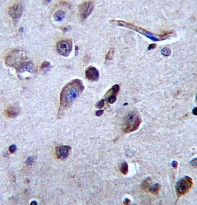ARG55826
anti-Translin antibody
anti-Translin antibody for ICC/IF,IHC-Formalin-fixed paraffin-embedded sections,Western blot and Human,Mouse
Overview
| Product Description | Rabbit Polyclonal antibody recognizes Translin |
|---|---|
| Tested Reactivity | Hu, Ms |
| Predict Reactivity | Bov, Hm |
| Tested Application | ICC/IF, IHC-P, WB |
| Host | Rabbit |
| Clonality | Polyclonal |
| Isotype | IgG |
| Target Name | Translin |
| Antigen Species | Human |
| Immunogen | KLH-conjugated synthetic peptide corresponding to aa. 109-138 (Center) of Human Translin. |
| Conjugation | Un-conjugated |
| Alternate Names | REHF-1; Translin; Component 3 of promoter of RISC; EC 3.1.-.-; C3PO; BCLF-1; TBRBP; RCHF1; TRSLN |
Application Instructions
| Application Suggestion |
|
||||||||
|---|---|---|---|---|---|---|---|---|---|
| Application Note | * The dilutions indicate recommended starting dilutions and the optimal dilutions or concentrations should be determined by the scientist. | ||||||||
| Positive Control | Jurkat |
Properties
| Form | Liquid |
|---|---|
| Purification | Purification with Protein A and immunogen peptide. |
| Buffer | PBS and 0.09% (W/V) Sodium azide |
| Preservative | 0.09% (W/V) Sodium azide |
| Storage Instruction | For continuous use, store undiluted antibody at 2-8°C for up to a week. For long-term storage, aliquot and store at -20°C or below. Storage in frost free freezers is not recommended. Avoid repeated freeze/thaw cycles. Suggest spin the vial prior to opening. The antibody solution should be gently mixed before use. |
| Note | For laboratory research only, not for drug, diagnostic or other use. |
Bioinformation
| Database Links | |
|---|---|
| Gene Symbol | TSN |
| Gene Full Name | translin |
| Background | This gene encodes a DNA-binding protein which specifically recognizes conserved target sequences at the breakpoint junction of chromosomal translocations. Translin polypeptides form a multimeric structure that is responsible for its DNA-binding activity. Recombination-associated motifs and translin-binding sites are present at recombination hotspots and may serve as indicators of breakpoints in genes which are fused by translocations. These binding activities may play a crucial role in chromosomal translocation in lymphoid neoplasms. This protein encoded by this gene, when complexed with translin-associated protein X, also forms a Mg ion-dependent endoribonuclease that promotes RNA-induced silencing complex (RISC) activation. Alternative splicing results in multiple transcript variants. [provided by RefSeq, May 2012] |
| Function | DNA-binding protein that specifically recognizes consensus sequences at the breakpoint junctions in chromosomal translocations, mostly involving immunoglobulin (Ig)/T-cell receptor gene segments. Seems to recognize single-stranded DNA ends generated by staggered breaks occurring at recombination hot spots. Exhibits both single-stranded and double-stranded endoribonuclease activity. May act as an activator of RNA-induced silencing complex (RISC) by facilitating endonucleolytic cleavage of the siRNA passenger strand. [UniProt] |
| Cellular Localization | Cytoplasm. Nucleus |
| Calculated MW | 26 kDa |
Images (3) Click the Picture to Zoom In
-
ARG55826 anti-Translin antibody ICC/IF image
Immunofluorescence: HeLa cells were fixed with 4% PFA (20 min), permeabilized with Triton X-100 (0.1%, 10 min), then stained with ARG55826 anti-Translin antibody (green) at 1:25 dilution, 1 hour at 37°C. Cytoplasmic actin was counterstained with Alexa Fluor® 555 (red) conjugated Phalloidin (7 units/ml, 1 hour at 37°C). DAPI (blue) for nuclear staining.
-
ARG55826 anti-Translin antibody IHC-P image
Immunohistochemistry: Formalin-fixed and paraffin-embedded Human brain tissue stained with ARG55826 anti-Translin antibody.
-
ARG55826 anti-Translin antibody WB image
Western blot: 35 µg of Jurkat cell lysate stained with ARG55826 anti-Translin antibody.








